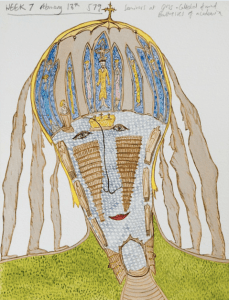I applied to present at AATA’s 2012 conference with an innovative and provacative idea—that I would discuss the possibility of using website design within an art therapy session in order to help process grief. You can read my abstract here, but here’s a highlight:
The idea of using a website as a virtual mural will be explored, which can be built and contributed to by one person or by numerous people across various geographic locations. The website as a tool to eternally memorialize the deceased will also be considered, since once material is posted on the internet it lives forever.
A few days ago, I received my rejection letter from AATA. They didn’t give a specific explanation for the rejection, however they did indicate several possibilities, such as a lack of interest in the topic. My gut reaction was that AATA dismissed the idea of web design as a form of art therapy, and for this reason I want to give a brief explanation of my rationale beyond what you can read in my abstract.
When I found out one of my closest friends, Jazz Virdee, was hit by a car and killed instantly while on vacation in the Dominican Republic, I couldn’t breathe. I was traveling myself and in a haze of disbelief, I managed to make my way back to our home town, Montreal. We planned to meet there in a few months, after her work with the UN in Haiti ended and we both had a little time. Never did I think we would be brought together again under these terrible circumstances.
Immediately after her death, Jazz’s Facebook page was full of posts expressing sadness, anger and disbelief as wells as condolences to her family. New pictures were posted each day. Anything that people found in their photo libraries that never made it on her page before. New friend requests began popping up too. Jazz’s sister, who had access to Jazz’s fb account, was touched by the outpouring of support but intended to delete the fb account on Jazz’s upcoming 30th birthday. My heart sank thinking there’d be no where to see pictures, old messages, old times…I wanted a place I could go to, to sit with the memories. And in this technological age, our memories were online or in the form of digital photographs, emails and Skype video conference (that I wish I had recorded). Plus Jazz kept a few blogs from her various travels, working for NGOs in Africa and Mongolia. I wanted one place that consolidated everything before the 30th birthday deadline. So, with the permission of Jazz’s family and friends (who are in the photos), I went ahead with a web design project to memorialize my dear friend.
A combination of digital scrap book and public mural, I looked through all the photographs I could find, reviewed the blogs, and attempted to find videos of Jazz. I chose the words to memorialize and express my grief. I chose the colors, the placement of photographs and the overall feel of the website. I also opened the site up for everyone to see, allowing comments and letting others know that if they wanted to have anything included to email me with the information.
As I worked, not only did I experience the same “flow” as I do with traditional art making, I also was able to take the time to process my thoughts, memories and emotions. Creating this website helped transition me from numbness and shock to feeling and processing.
Now, I know most art therapists are not comfortable with web design. But, then again, I’m not comfortable with woodworking or silkscreening. There are forms of traditional art media that I’ve never dabbled in and that many art therapists don’t use in their practices. However, if the majority of art therapists chose not to engage in certain forms of art making, does that close off these practices from the field of art therapy? Of course not. Doll making is an acceptable art therapy practice, even though the majority of art therapists don’t use doll making in their sessions. Then it stands to reason that although rare and very new, digital art making in the form of a website is an acceptable practice within an art making session—as long as the therapist is skilled enough to facilitate the process with their clients.
Lastly, I’d love to hear your thoughts about this subject, and the (inevitable) morphing of art making into unexpected forms of digital media :) Growing pains of a new era!









